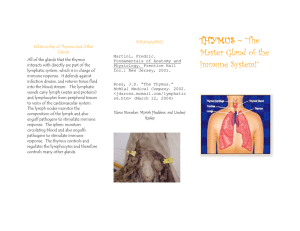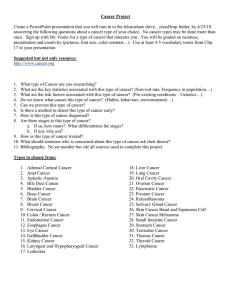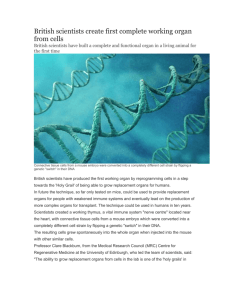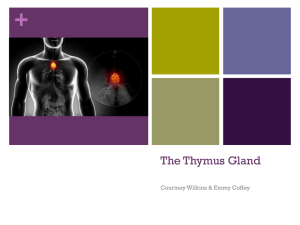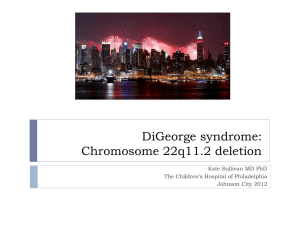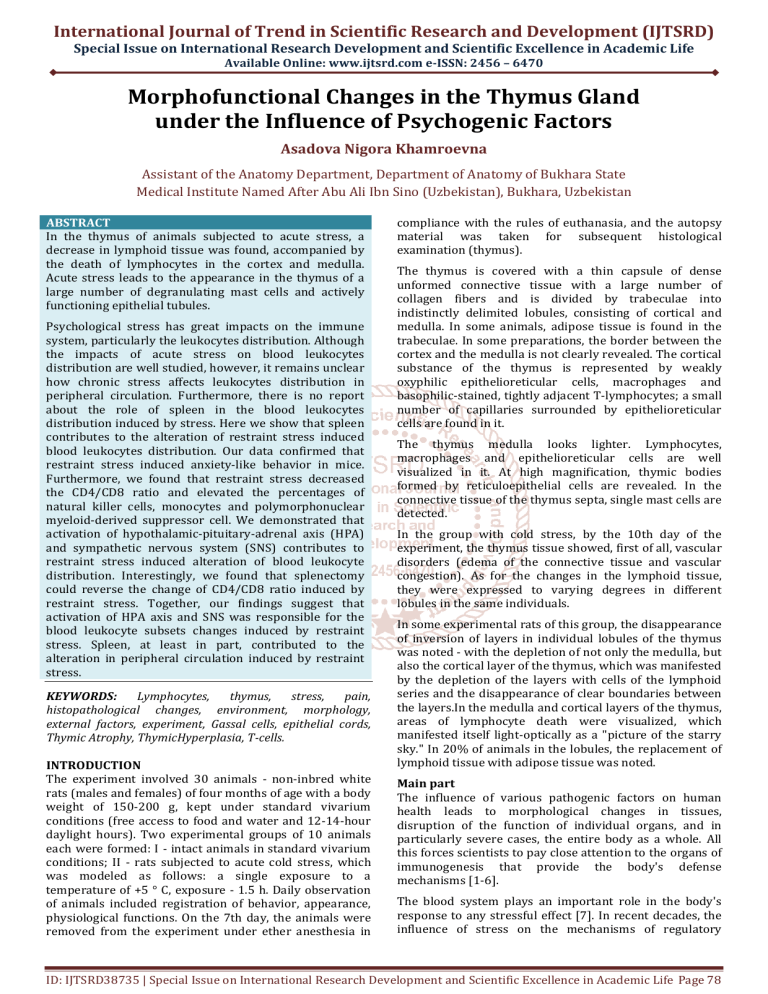
International Journal of Trend in Scientific Research and Development (IJTSRD)
Special Issue on International Research Development and Scientific Excellence in Academic Life
Available Online: www.ijtsrd.com e-ISSN: 2456 – 6470
Morphofunctional Changes in the Thymus Gland
under the Influence of Psychogenic Factors
Asadova Nigora Khamroevna
Assistant of the Anatomy Department, Department of Anatomy of Bukhara State
Medical Institute Named After Abu Ali Ibn Sino (Uzbekistan), Bukhara, Uzbekistan
ABSTRACT
In the thymus of animals subjected to acute stress, a
decrease in lymphoid tissue was found, accompanied by
the death of lymphocytes in the cortex and medulla.
Acute stress leads to the appearance in the thymus of a
large number of degranulating mast cells and actively
functioning epithelial tubules.
Psychological stress has great impacts on the immune
system, particularly the leukocytes distribution. Although
the impacts of acute stress on blood leukocytes
distribution are well studied, however, it remains unclear
how chronic stress affects leukocytes distribution in
peripheral circulation. Furthermore, there is no report
about the role of spleen in the blood leukocytes
distribution induced by stress. Here we show that spleen
contributes to the alteration of restraint stress induced
blood leukocytes distribution. Our data confirmed that
restraint stress induced anxiety-like behavior in mice.
Furthermore, we found that restraint stress decreased
the CD4/CD8 ratio and elevated the percentages of
natural killer cells, monocytes and polymorphonuclear
myeloid-derived suppressor cell. We demonstrated that
activation of hypothalamic-pituitary-adrenal axis (HPA)
and sympathetic nervous system (SNS) contributes to
restraint stress induced alteration of blood leukocyte
distribution. Interestingly, we found that splenectomy
could reverse the change of CD4/CD8 ratio induced by
restraint stress. Together, our findings suggest that
activation of HPA axis and SNS was responsible for the
blood leukocyte subsets changes induced by restraint
stress. Spleen, at least in part, contributed to the
alteration in peripheral circulation induced by restraint
stress.
KEYWORDS:
Lymphocytes,
thymus,
stress,
pain,
histopathological changes, environment, morphology,
external factors, experiment, Gassal cells, epithelial cords,
Thymic Atrophy, ThymicHyperplasia, T-cells.
INTRODUCTION
The experiment involved 30 animals - non-inbred white
rats (males and females) of four months of age with a body
weight of 150-200 g, kept under standard vivarium
conditions (free access to food and water and 12-14-hour
daylight hours). Two experimental groups of 10 animals
each were formed: I - intact animals in standard vivarium
conditions; II - rats subjected to acute cold stress, which
was modeled as follows: a single exposure to a
temperature of +5 ° C, exposure - 1.5 h. Daily observation
of animals included registration of behavior, appearance,
physiological functions. On the 7th day, the animals were
removed from the experiment under ether anesthesia in
compliance with the rules of euthanasia, and the autopsy
material was taken for subsequent histological
examination (thymus).
The thymus is covered with a thin capsule of dense
unformed connective tissue with a large number of
collagen fibers and is divided by trabeculae into
indistinctly delimited lobules, consisting of cortical and
medulla. In some animals, adipose tissue is found in the
trabeculae. In some preparations, the border between the
cortex and the medulla is not clearly revealed. The cortical
substance of the thymus is represented by weakly
oxyphilic epithelioreticular cells, macrophages and
basophilic-stained, tightly adjacent T-lymphocytes; a small
number of capillaries surrounded by epithelioreticular
cells are found in it.
The thymus medulla looks lighter. Lymphocytes,
macrophages and epithelioreticular cells are well
visualized in it. At high magnification, thymic bodies
formed by reticuloepithelial cells are revealed. In the
connective tissue of the thymus septa, single mast cells are
detected.
In the group with cold stress, by the 10th day of the
experiment, the thymus tissue showed, first of all, vascular
disorders (edema of the connective tissue and vascular
congestion). As for the changes in the lymphoid tissue,
they were expressed to varying degrees in different
lobules in the same individuals.
In some experimental rats of this group, the disappearance
of inversion of layers in individual lobules of the thymus
was noted - with the depletion of not only the medulla, but
also the cortical layer of the thymus, which was manifested
by the depletion of the layers with cells of the lymphoid
series and the disappearance of clear boundaries between
the layers.In the medulla and cortical layers of the thymus,
areas of lymphocyte death were visualized, which
manifested itself light-optically as a "picture of the starry
sky." In 20% of animals in the lobules, the replacement of
lymphoid tissue with adipose tissue was noted.
Main part
The influence of various pathogenic factors on human
health leads to morphological changes in tissues,
disruption of the function of individual organs, and in
particularly severe cases, the entire body as a whole. All
this forces scientists to pay close attention to the organs of
immunogenesis that provide the body's defense
mechanisms [1-6].
The blood system plays an important role in the body's
response to any stressful effect [7]. In recent decades, the
influence of stress on the mechanisms of regulatory
ID: IJTSRD38735 | Special Issue on International Research Development and Scientific Excellence in Academic Life Page 78
International Journal of Trend in Scientific Research and Development (IJTSRD) @ www.ijtsrd.com eISSN: 2456-6470
processes in humans and animals has been actively
studied, its role in the adaptation process with the
participation of cytokines and antioxidants has been
shown on models of emotional, pain, traumatic and other
stresses and also the fact that under the action of stress, all
regulatory information goes from the nervous system
through the pituitary-adrenal, lymphoid system and
hematopoietic organs, and the general adaptation
syndrome develops against the background of the
restructuring of the activity of the local microenvironment,
in which stromal elements and cytokines play an
important role [7]. Nevertheless, today there are many
unresolved issues in the pathomorphological changes in
the organs of immunogenesis under stress, which
determines the relevance of research in this direction.
The process of age-related involution,an evolutionarily
ancient process inherent in all vertebrates, stands apart
[15]. One of the characteristic features of true age
involution is its irreversibility under physiological
conditions. Recovery of the thymus after involution due to
gonadectomy, administration of luteinizing hormone or
growth hormone is shown.
An absolute decrease in thymus mass correlates with the
onset of puberty. The thymus, which has undergone agerelated involution, is an accumulation of adipose tissue
with remains of the parenchyma containing islets of
epithelial cells and thin strands of a few thymocytes with
Gassal cells. However, involution is never complete,small
islands of the thymus parenchyma are found even in
people older than 80 years [16].
In all animals of the group (100%, p <0.05 with respect to
control), inversion of layers was also observed, which is
typical for the 3rd phase of accidental thymic involution
under stress [8].
The blood vessels in the devastated cortex had a structure
typical of the vessels of the thymus medulla. It is known
that the hemocapillaries of the cortical layer have a
relatively thick basement membrane, to which
epithelioreticulocytes, macrophages and lymphocytes
often adjoin; the basement membrane of the medullary
hemocapillaries, on the contrary, is thin [7].
Also, in the cortex and medulla, areas of stromal
collagenization and the formation of a large number of
thymic bodies were detected.
In the thymus tissue, a large number of mast cells were
detected - large cells with basophilic granules. They were
found mainly in the interlobular connective tissue, in the
connective tissue of the septa inside the lobules in the
vicinity of the blood
Mast cells are an integral part of the thymic
microenvironment; their main function is to control the
composition of tissue fluid, they are regulators of tissue
homeostasis and the last link in the general adaptation
reaction at the cellular level, in the thymus they are
actively involved in the processes of differentiation and
migration of thymocytes [13]. In 70% of animals, epithelial
tubules lined with cubic epithelial cells were also detected
in the cortical layer of the lobules.
It is known that epithelial tissue plays a leading role in the
implementation of the functions of the thymus; at the same
time, both in the human thymus and in the thymus of
laboratory animals, epithelial tubules, thymic bodies and
epithelial accumulations are permanent structures [13]. In
2009, only one term was introduced into the
nomenclature, referring to the epithelial structures of the
thymus, thymic body; the combination of three types of
epithelial formations of the thymus (epithelial cords,
epithelial tubules and thymic bodies) under one general
term is conditional and inhibits the development of ideas
about the structure of the thymus [12].
Most researchers explain the proliferation of epithelial
structures in the thymus by the emergence of an urgent
need to enhance the secretion of thymic hormones under
extreme exposure [9, 10]. The cavity forms of the tubules
can be constantly determined with the tension of the
functional activity of the thymus, expressed in a change in
the emigration and immigration of lymphocytes in the
organ - not only in the embryonic, early postnatal and
senile periods of genesis, but also under the influence of
stress factors on the body. In accordance with modern
ideas about the functions of the thymus, all these periods
of life characterized by an unbalanced supply of Tprecursors from the bone marrow to the thymus and
emigration from the thymus to the peripheral lymphoid
organs of T-lymphocytes that have passed the intrathymic
stage of maturation; at the same time, not only mature Tlymphocytes migrate from the thymus to the lymphoid
organs, but also immature forms, which are able to mature
in these organs under the influence of thymic factors [12].
Thus, when comparing the data of histological examination
of the organs of animals of the experimental and control
groups, the following patterns were revealed. In rats
subjected to acute stress, changes in the organs of the
immune system were found, characteristic of acute stress,
a decrease in lymphoid tissue - in the thymus
The study of the thymus as a central organ of the immune
system under stress is of particular interest to date.
Later, many researchers have shown that accidental
involution of the thymus develops not only when exposed
to an infectious agent, but also when various factors affect
the body [7].
Under stress conditions, incidental involution of the
thymus reflects suppression of its function [11].
Generalization of the information available to date in the
literature makes it possible to represent this process as a
sequential change of five phases; at the same time, the
processes of death and migration of T-lymphocytes in
different lobules are uneven, and the absence of strict
parallelism of changes in lobules is reflected in the
morphological picture of one stage or another, in addition,
the nature of the response of the thymus to the stressor
depends on the nature of the stressor [7].
At the same time, according to other authors, lymphopenia
in lymphoid organs during stress reaction develops not as
a result of cell breakdown, but due to a decrease in
neoplasm and increased migration of lymphocytes from
these organs to the bone marrow with the formation of a
“lymphoid peak”. It is known that lymphocytopenia
accompanies stress practically throughout all its stages,
but it is most pronounced in the stage of anxiety and in the
stage of exhaustion (especially), which is characterized by
almost complete atrophy of the thymus [14].
ID: IJTSRD38735 | Special Issue on International Research Development and Scientific Excellence in Academic Life Page 79
International Journal of Trend in Scientific Research and Development (IJTSRD) @ www.ijtsrd.com eISSN: 2456-6470
Thus, in the central and peripheral organs of
immunogenesis of animals subjected to acute cold stress,
we observed similar changes, which are manifestations of
acute stress, the reduction of lymphoid tissue. In the
thymus, the reaction of reticuloepithelial structures and
mast cells was also revealed.
With acute stress exposure, the central nervous system is
activated, which triggers a stress response. It consists in
the fact that the peripheral nervous system is activated,
and various hormones begin to be released by the
endocrine glands. In the body, there is a violation of
biochemical processes, which leads to undesirable changes
in tissues and organs. The organs responsible for
immunity are affected. In the blood, the level of hormones
- glucocorticoids, a high concentration of which suppresses
the body's immune system, sharply increases. In acute
stress, the gender difference is sharply manifested. In
female rats, after acute stress, the immune response
increases significantly, resulting in faster recovery. In
males, the reaction is the opposite, so healing is slower.
This study also confirms human sociology, according to
which socially isolated men are more difficult to tolerate
stress and illness than isolated women. Scientists do not
know why women are quicker to restore your immune
system after stress than men. Perhaps this is due to the
fact that in this way they subconsciously protect the health
of their future children. Thus, men who are socially
isolated are more susceptible to diseases and live less than
women who are isolated. Scientific studies in laboratory
mice have shown that short-term stress increases the
strength and duration of the immune response. In another
study, in which mice were placed for two hours in the
same cage with more aggressive counterparts, it was
found that such stress increased the response to the flu
virus. Acute positive stress strengthens the immune
system regardless of gender and accelerates the healing
process of minor injuries. In the case of short-term stress
effects, in contrast to the effects of chronic stress, there are
no clinical manifestations of psychological and
physiological dysfunctions associated with a violation of
the immune system. Underestimation of the state of health,
inadequate treatment and, as a result, aggravation of the
picture of the disease can be dangerous here [18].
The restoration of the structure and function of the
immune defense occurs gradually. At first, the cell depots
begin to fill up, because due to the decrease in the stress
effect, there is no need for an increased content of immune
cells in the periphery. There is time for the maturation of
cellular elements. Soon the periphery is filled with mature
immune cells necessary for the life of a healthy body. For
future acute stress, there is a reserve of mature and
maturing elements in the depot and organs of the immune
system. When restoring psychophysiological functions, if
the stage of exhaustion has not occurred, and the
sympathetic part of the nervous system dominates, with
relaxation or active correction, the immune system
normalizes [17, 19].
Research results
The experiment involved 30 animals - non-inbred white
rats (males and females) of four months of age with a body
weight of 150-200 g, kept under standard vivarium
conditions (free access to food and water and 12-14-hour
daylight hours). Two experimental groups of 10 animals
each were formed: I - intact animals in standard vivarium
conditions; II - rats subjected to acute cold stress, which
was modeled as follows: a single exposure to a
temperature of +5 ° C, exposure - 1.5 h. Daily observation
of animals included registration of behavior, appearance,
physiological functions. On the 7th day, the animals were
removed from the experiment under ether anesthesia in
compliance with the rules of euthanasia, and the autopsy
material was taken for subsequent histological
examination (thymus).
Chronic stress has a marked regulating effect on the
immune system of growing animals, one manifestation of
which is the change in the structural and
immunocytochemical characteristics of the thymus, typical
immunosuppressive conditions, namely: reduction in size
of the thymus and a decrease in its cellular density,
reduction of cortico-cerebral ratio, the number СБ90+ and
СБ8+ thymocytes in the cortical substance of the thymus,
DBA+thymocytes in the cortex and the medulla of the
thymus, increased death of thymocytes and inhibition of
their proliferation in the cortical substance of the thymus.
The sensitivity of the immune system of a growing
organism to the action of various types of stressors
(physical versus psychoemotional) depends on the initial
age. According to an immunohistochemical study, physical
stressors cause a sharp immunosuppression in infancy,
while emotionogenic stressors significantly less change
the immunoarchitectonics of the organ during this period.
In the suckling period, a greater sensitivity of the thymus
to the action of physical stressors remains with an
increase in the strength of the immunomodulatory action
of psycho-emotional stressors, and by the end of the
infantile period, the immunosuppressive effect of
emotsiogenic stressors is practically compared with that of
physical stressors.
Conclusion
The thymus of immature experimental animals of the age
of transition to independent nutrition is the most sensitive
to the immunosuppressive effect of chronic stress, which,
according to immunohistochemical research, causes the
highest degree of accidental involution of the thymus in
animals of the suckling period compared to animals of the
infant and infantile periods.
The leading mechanisms of thymus involution in chronic
stress in a growing organism are excessive apoptosis of
double positive thymocytes of the thymus cortex and
inhibition of lymphocyte proliferation in it.
Immunohistochemical methods of research significantly
expand the possibilities of assessing the dynamics of
thymus immunoarchitectonics under stress, among them
the most informative are staining on CD8, PCNA and ED1,
which allows not only to state the presence and direction
of changes, but also to decipher their mechanism.
Reference
[1] Asadova N.H. Morphofunctional features of the
thymus in normal and under the influence of a
biostimulator on the background of radiation
sickness// New day in medicine -2020-№1(30). P.194-196.
[2]
Bulgakova O. S. Psychosomatic normalization in the
modern world / / Fundamental research. - 2008. No. 6. - pp. 56-57.
ID: IJTSRD38735 | Special Issue on International Research Development and Scientific Excellence in Academic Life Page 80
International Journal of Trend in Scientific Research and Development (IJTSRD) @ www.ijtsrd.com eISSN: 2456-6470
[3]
Kalinina N. M. Trauma: inflammation and immunity
/ / Cytokines and inflammation. - 2005. - № 4. - C.
28-35.
[4]
Khasanova D. A. Macroanatomy of payer’s patches
of rat’s small intestine under the influence of
antiseptic stimulatorтdorogov faction 2 on the
background of chronic radiation sickness// New
day in medicine - 2020. -№1(30). - P.21-24.
[5]
Khasanova
D.
A.
Wirkungeines
genmodifiziertenprodukts auf die morphologischen
parameter
der
strukturen
der
milzweißerrattenScientific collection “Interconf”
Science and practice: implementation to modern
society Great Britain. 2020; PP. 1258-1261
[6]
Khasanova D. A., TeshaevSh. J. Topograficanatomical features of lymphoid structures of the
small intestine of rats in norm and against the
background of chronic radiation diseases //
European science review. Medical science. Vienna,
Austria. – 2018. Vol. 2. - №9-10. - P. 197-198.
[7]
Khasanova DA, Teshaev SJ. Effects of genetically
modified products on the human body (literature
review), 2020; 5(45): 5-19
[8]
Khasanova DA. Current problems of safety of
genetically modified foods (literature review),
2020; 5 (45): 20-27
[9]
Kiseleva N. M, Kuzmenko L. G, NkaneNko-za M. M.
Stress and lymphocytes. Pediatrics 2012; 91 (1):
137-143.
[10]
LatyushinYa. V. Regularities of molecular-cellular
adaptive processes in the blood system during acute
and chronic hypokinetic stress: author. dis. ... Dr.
biol. sciences. Chelyabinsk 2010; 40.
[11]
Michurina S. V, Vasendin D. V., Ishchenko I. Yu.,
Zhdanov A. P. Structural changes in the thymus of
rats after exposure to experimental hyperthermia.
Bulletin of the Volgograd Scientific Center of the
Russian Academy of Medical Sciences 2010; 1: 3033.
[12]
Mikhailenko A. A., Bazanov G. A., Pokrovsky V. I. et
al. Preventive immunology, Moscow: Meditsina,
2004, 154 p.
[13]
Obukhova L. A Structural transformations in the
system of lymphoid organs under the action of
extremely low temperatures on the body and under
conditions of correction of the adaptive reaction
with polyphenolic compounds of plant origin:
author. dis. ... Dr. med. sciences. Novosibirsk 1998;
36.
[14]
Pertsov SS Effect of melatonin on the state of the
thymus, adrenal glands and spleen in rats under
acute stress load. Bulletin of Experimental Biology
and Medicine 2006; 33: 263-266.
[15]
Raica M., Cimpean A.M., Encica S. et al. Involution of
the thymus: a possible diagnostic pitfall. Rom. J.
Morphol. Embryol. 2007; 48 (2):101–6.
[16]
Shanley D.P., Aw D., Manley N.R. et al. An
evolutionary perspective on the mechanisms of
immunosenescence. Trends Immunol. 2009;30 (7):
374–81.
[17]
Trufakin V. A, Shurlygina AV, Letyagin A Yu.
Circadian organization of structural and functional
parameters of the immune and endocrine systems
in hybrid mice (CBA x C57B2) F1. Immunology
1990; 2: 43-45.
[18]
Voloshin N. A., Grigoriev E. A. Thymus of newborns.
Zaporizhzhia 2011; 154.
[19]
Zabrodskiy PF Changes in nonspecific resistance of
the organism and immune status in acute
arsenitepoisoning. Saratov 2012; 157.
ID: IJTSRD38735 | Special Issue on International Research Development and Scientific Excellence in Academic Life Page 81

